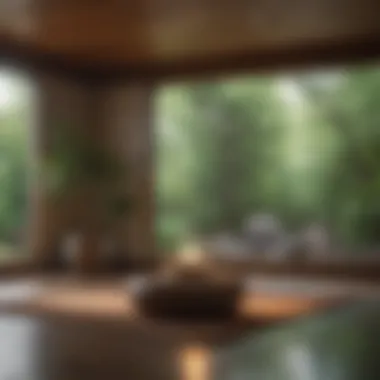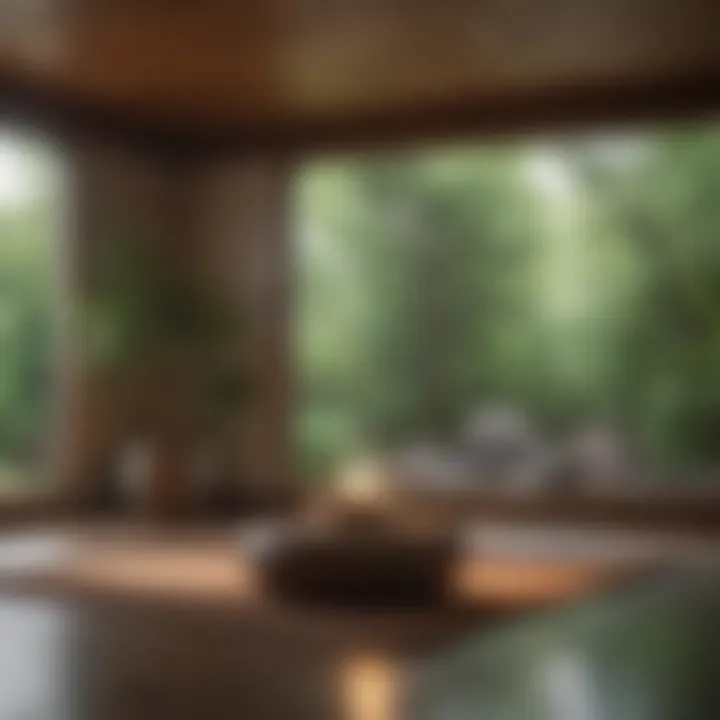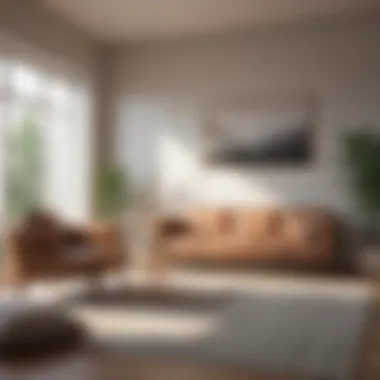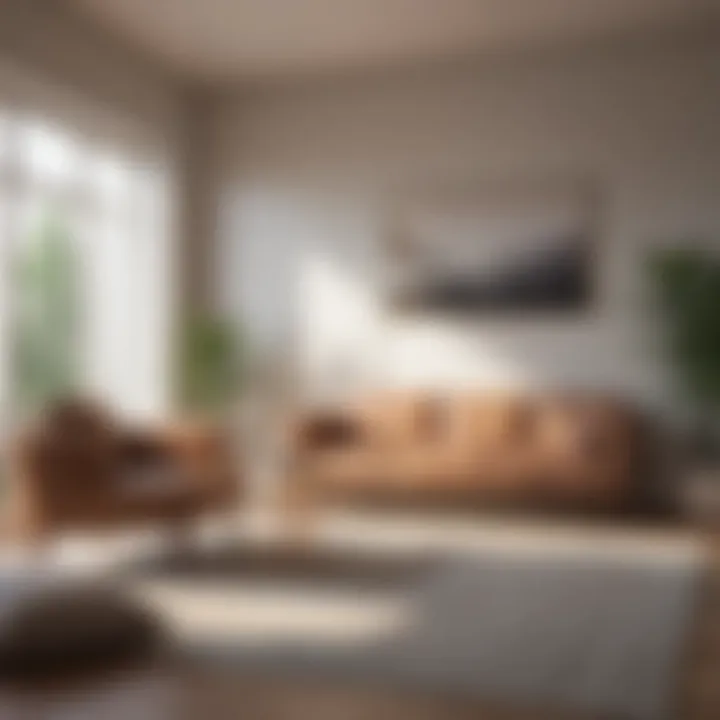Create Your Perfect Meditation Room for Serenity


Intro
Creating a meditation room is not just about physical space; it is about the energy and atmosphere you cultivate within that space. Whether you're looking to escape the chaos of everyday life or seeking a dedicated area for mindfulness practices, every element contributes to making the room a haven for tranquility.
Types of Guided Meditation
When you're setting up your meditation room, consider the type of guided meditation that resonates with you. Each style serves unique purposes and can influence the environment you need to create. Here, we delve into some popular practices:
Mindfulness Meditation
Mindfulness meditation focuses on being present. It involves concentrating on your breath, recognizing thoughts without judgment, and cultivating awareness of your surroundings. To enhance this meditation style, consider incorporating soft, neutral colors on walls and adding natural elements like plants to create a calm ambiance that emphasizes simplicity.
Sleep Meditation
For those struggling with sleep, a room designed with sleep meditation in mind can be beneficial. This type of meditation helps in winding down, often including soothing sounds or guided imagery aimed at promoting relaxation. Dim lighting, soft fabrics, and comfortable seating arrangements play a pivotal role in setting the right mood.
Benefits of Guided Meditation
The intentional design of your meditation space can lead to profound benefits that reach far beyond the time spent in quiet reflection.
- Mental Clarity and Focus: A dedicated meditation room can help sharpen your focus, allowing for deeper engagement with your thoughts.
- Improved Sleep Quality: By integrating sleep meditation practices into your space, restful sleep may become more attainable.
"Creating a space for meditation allows you to foster a sense of community with yourself, cultivating growth and inner peace."
Having an understanding of different meditation types and their benefits sets the foundation for creating a space that is conducive to your mental and emotional well-being. With that understanding, we can transition into assessing how to create the best room tailored to your personal needs.
Choosing the Right Location
When it comes to crafting an ideal meditation room, the location you select plays a paramount role. This choice affects the overall atmosphere and experience you create, impacting how effectively you can unwind and center yourself amidst the chaos of daily life. A well-chosen spot lays the groundwork for tranquility, allowing your meditation practice to flourish. The right space not only protects you from distractions but also fosters a sense of peace.
Evaluating Available Spaces
Starting with an assessment of available spaces in your home or dedicated venue is a good idea. Think about the different rooms and areas and ask yourself which might provide the quietest environment. A corner of your bedroom or a spare room could serve as good options, provided they have some level of solitude. Alternatively, a sunroom or patio may offer a refreshing change if you like being outdoors.
Consider elements such as accessibility. It shouldn’t be too far out of your daily routine, making it easy to integrate meditation into your life. A place that’s visible from your daily path may encourage its use without much hassle.
Understanding Environmental Influences
Noise levels
Noise levels can significantly influence your meditation quality. A space surrounded by clamoring streets or boisterous rooms might send your serenity packing. The key characteristic of noise levels is their power to disrupt your focus, especially during silent meditation. Ideally, it helps to choose a location where ambient sounds are minimal. If you can’t escape noise altogether, consider soundproofing solutions or using 'white noise' as a backdrop. This can mask sudden distractions, allowing you to dive deeper into your practice.
"Silence is the ultimate luxury, yet an elusive state in today’s environment. Control your surroundings for effective meditation".
Natural light
Natural light contributes substantially to the overall mood of your meditation area. Rooms filled with sunlight generally feel more open and welcoming. Natural light not only enhances your space’s aesthetics but also positively affects your mood, which is crucial for effective meditation. Just think about that warm morning sun filtering through your window—such a pleasant way to start your reflection. If you’re inclined to meditate at dawn or dusk, having ample natural light is doubly vital, as dim surroundings can hinder your clarity.
However, too much light can sometimes be overwhelming. Placing curtains or shades gives you control over the amount of sunlight that seeps in, allowing you to adjust according to your preference and mood.
Air quality
Air quality can greatly affect your overall well-being and focus. Stagnant or poor-quality air may leave you feeling restless and uneasy. A space with good ventilation is a beneficial choice, helping you breathe freely and reconnect with yourself. Fresh air can elevate energy levels, support concentration, and create a sense of comfort. Consider opening windows or using air-purifying plants to enhance the atmosphere further. On the other hand, be mindful of allergens that could irritate your senses and detract from your meditative practices.
In summary, the significance of selecting the appropriate location cannot be overstated. Noise, natural light, and air quality are crucial factors to consider when aiming for the ideal meditation environment.
Furnishing Your Meditation Room
Creating a meditation room goes beyond the simple act of finding a space and throwing in a few cushions. The furnishing of your meditation room plays a crucial role in shaping the entire experience of mindfulness and tranquility. Well-chosen furnishings can enhance comfort, encourage relaxation, and help in centering your thoughts. It also impacts how you interact with your environment, driving home the feel for a sanctuary—a cherished personal retreat that resonates with peace.
Selecting Comfortable Seating
Chairs vs. Cushions
When considering seating options, the debate between chairs and cushions can feel like a tight squeeze in a packed subway. Each has its merits. Chairs, especially those designed for wellness, can keep your posture aligned, which is essential for long meditation sessions. They often come with back support, allowing you to relax without worrying about straining your muscles. However, they might not provide that sense of grounding that cushions offer.
Cushions, on the other hand, are portable, adaptable, and can encourage a more connected experience with the floor. Their soft, embrace tends to cradle you, making it easier to settle into that zen-like state. A solid benefit for cushions is their diverse range of styles—some are even designed to assist with different types of meditation practices, like zafu cushions for seated meditation. But, one should consider that cushions may not provide the same level of support for those who have back problems.
In summary, whether opting for chairs or cushions, the best choice often hinges on personal comfort and the specifics of your meditation practice.
Adjustable Options
Flexibility in seating cannot be overstated. Adjustable options, like chairs with height settings or cushioned benches that allow for various postures, can make a significant difference in how you experience your space. This adaptability caters to individual needs and can truly be a game-changer if you're sharing the room with others. It allows everyone to tailor their seating to their preferences, which enhances comfort and encourages longer sessions without the grim discomfort that can creep up unexpectedly.
Notably, adjustable options often incorporate ergonomic designs as well. This means that aside from just being versatile, they also support the natural curves of your body, which can lead to better focus during meditation. However, the complexity and price tag of these adjustable solutions can turn some away. It may take some effort to find the perfect fit that aligns with your aesthetic while also being functional.
Incorporating Storage Solutions
Storage might not seem like the centerpiece of your meditation room, but a clutter-free zone promotes clarity of thought. When everything has a home, you can dive into your meditation without the distraction of mismatched items lying around.
Organizational Tools
The right organizational tools can do wonders for creating an atmosphere of calm. Shelving units, baskets for cushions, or even a small cabinet for your meditation props can keep your space tidy and purposeful. High-quality organizational tools not only provide storage but can also serve as decor, echoing the tranquility you're aiming for.


Consider that open shelves allow for both storage and display. You might showcase inspiring books, spiritually resonant items, or even minimalistic decor that aligns with your meditation style. On the downside, having too many decorative items can risk the space feeling cluttered, which is counterproductive.
Distraction Management
Distraction management can flow from how you structure your space to the items you place within it. For instance, using storage for your tech gadgets or work materials can help eliminate the visual reminders of daily life that could invade your peace. This focus on organization fosters an environment that encourages mindfulness rather than distraction.
Consider integrating simple bins or drawers where you can tuck away any items that might divert your attention. In this strategy, simplicity reigns—less is indeed more. A drawback, however, might be if you tend to forget where you've placed items; organization relies on knowing how to function within your space.
Ultimately, furnishing your meditation room means finding that balance between comfort, functionality, and style. With considered choices, your meditation practice can flourish, transforming a simple room into a holistic journey into relaxation.
Choosing the Right Colors
Choosing the right colors for your meditation room is not just about aesthetics; it's about creating an environment that nurtures peace and mindfulness. Colors can evoke powerful emotions and set the tone for your practice. They influence how you feel and how you interact with the space around you. Therefore, considering both the hues and shades will help you channel the essence of tranquility and awareness that enhances your meditation experience.
Understanding Color Psychology
Calming Colors
When we talk about calming colors, shades such as soft blues, muted greens, and gentle lavenders often come to mind. These hues are celebrated for their ability to induce relaxation and serenity. Soft blue, for example, mimics the calmness of a clear sky or a tranquil sea. It has an innate quality that lowers blood pressure and slows heart rate, paving the way for peaceful meditation practices.
- Key Characteristics: Calming colors typically have a cool undertone, making them visually soothing.
- Advantages: Such colors help diminish anxiety and create a sense of safety and comfort in your meditation room. They allow you to immerse yourself in meditation without the distractions of overly stimulating colors.
- Consideration: It's vital to balance these colors with natural elements such as wood or stone to prevent the space from feeling overly cold.
Invigorating Hues
On the flip side, invigorating hues, like bright yellows and warm oranges, can also find their place in a meditation room. These colors are associated with energy, enthusiasm, and positivity. For instance, sunny yellow mirrors the joy of a bright morning, which can be refreshing when included strategically.
- Key Characteristics: Invigorating hues carry a warmer tone that can uplift spirits and stimulate creativity.
- Advantages: They can be excellent for morning meditations, making the practice feel lively and vibrant. Used in moderation, these colors can heighten motivation and inspire a fresh perspective on your practice.
- Consideration: Too much vivid color, however, can be overwhelming; therefore, it’s best used as accents rather than the primary color.
Creating a Harmonious Palette
When designing your meditation room, the objective is to create a harmonious palette that resonates with your personal sense of peace. This means blending calming colors and invigorating hues in a way that feels natural.
- Balance: Aim for a mix of base and accent colors that creates balance. For instance, you might have a light blue wall complemented by accents of warm yellow through cushions or artwork.
- Texture and Depth: Combining different materials and textiles in your chosen colors can also add depth. Think of soft fabric on cushions and airy curtains that catch the gentle breeze while maintaining your color scheme.
- Flexibility: Remember that as your meditation practice evolves, your color palette can change too. What feels harmonious today may shift down the road as your needs transform.
A harmonious color palette not only beautifies your space but also enhances your meditation experience by mirroring your internal state.
By mindfully selecting colors that resonate with your emotions and intentions, you transform your meditation room into a true sanctuary, fostering mindfulness and clarity.
Enhancing Atmosphere with Lighting
Lighting plays a pivotal role in setting the mood within your meditation room. The right lighting can foster a sense of calm and relaxation, helping the mind to drift away from daily stressors and delve into a deeper state of mindfulness. Conversely, harsh or insufficient lighting can disrupt the tranquility and focus needed for meditation. When designing your ideal meditation space, it’s essential to enhance the atmosphere through strategic lighting choices, ensuring that every glow and shadow contributes positively to your experience.
Utilizing Natural Light
Natural light is often touted as a boon for mental well-being. It not only brightens the room but also connects you with the outside world, which can be refreshing. Sunlight streaming through the windows during your meditation can help regulate your circadian rhythm and enhance your mood. When evaluating the location of your meditation room, consider how much natural light it receives throughout the day.
- Position your space: Ideally, situate your meditation room in a spot that receives sunlight, such as south or west-facing windows.
- Use sheer curtains: These can filter natural light while providing some privacy without completely blocking it out.
There lies a delicate balance; too much sunlight can feel overpowering. Therefore, have the flexibility to adjust the exposure based on the time of day and your personal preference.
Implementing Adjustable Artificial Lighting
For those who find themselves meditating at various times, adjustable artificial lighting becomes essential. It allows you to adapt the room's ambiance based on your mood and preference, providing the flexibility to create a calming atmosphere regardless of external conditions.
Soft lighting fixtures
Soft lighting fixtures are popular for their ability to create a warm and inviting atmosphere. These lights tend to emit a diffused glow that envelops the room in a gentle embrace, minimizing harsh shadows and glaring brightness. Soft lights can help lower anxiety levels, making it easier to ease into your meditation practice.
- Key characteristic: They often come with options for various intensities, allowing you to choose how dim or bright you want the space.
One unique feature of soft lighting fixtures is that they can mimic candlelight or the warm glow of sunrise, bridging the gap between artificial and natural illumination. This subtle replication enhances relaxation and aids in creating a peaceful retreat.
Light dimmers
Light dimmers offer another layer of control, allowing you to adjust brightness on a whim. This adaptability is beneficial, especially when transitioning from busy, bright environments into the tranquility of your meditation room. By leveraging dimmers, you can create an intensity that aligns with your meditation technique, whether it be a full-focus session or a more mellow, reflective practice.
- Key characteristic: They permit fine-tuning of light levels, accommodating everyone’s preferences at different times.
One unique advantage of light dimmers is their energy-saving capabilities; by adjusting light levels, you can reduce consumption without sacrificing comfort. However, some might find installation a bit complex, thus requiring a bit of research or hiring a professional.
"The quality of your meditation isn’t decided just by the stillness in the room but also how light dances within it."
By thoughtfully considering how you use both natural and artificial lighting, you can craft a multi-dimensional atmosphere that envelops you in tranquility, setting the stage for profound meditative experiences.
Incorporating Sound Elements
Creating a meditation room that truly resonates with peace requires attention to the auditory aspect. Sound is frequently an overlooked dimension in the design of your tranquil sanctuary, yet it plays an essential role in shaping the atmosphere. Whether it’s soothing music, gentle nature sounds, or the subtle hum of a sound machine, carefully selected audio elements can significantly enhance your meditation practice. These elements not only block out intrusive noises but also help establish a deeper state of relaxation and mindfulness.
Choosing the Right Background Music
Relaxing instrumental
Relaxing instrumental music serves as an inviting backdrop for meditation. Its key characteristic is the lack of lyrics, which often distract the mind. Instead, the soft melodies and harmonious arrangements allow individuals to focus inward, ushering thoughts away without interference. This style of music is popular among practitioners because it often features gentle pianos, strings, and ambient sounds that conjure images of serenity.


One unique feature of this genre is its adaptability. You can find everything from minimalist compositions to richer orchestrations that suit varying preferences. The advantages here are clear: relaxing instrumental music can enhance concentration, reduce anxiety, and support a profound meditative state. However, an important consideration is volume control; too loud and it risks becoming an irritation rather than a comforting presence.
Nature sounds
Nature sounds are another compelling option, known for their calming properties. The rhythmic quality of waves lapping against the shore, the whispers of wind through trees, or the cheerful trill of birds all connect us with the world outside, promoting a sense of grounding. Their key characteristic is their organic and spontaneous nature, which can promote emotional healing and reduce stress levels.
People find these sounds beneficial because they can evoke memories of peaceful outdoor experiences, creating a familiar setting that feels safe and nourishing. One unique feature of nature sounds is their capacity to provoke a physiological response; even in small doses, they can slow your heart rate, lower blood pressure, and improve overall wellbeing. However, not everyone appreciates them equally—some might find them too distracting in their quest for stillness.
Utilizing Sound Machines
Sound machines have gained popularity for their ability to generate a consistent auditory backdrop conducive to relaxation. Devices that simulate rainfall, white noise, or ocean waves help mask sudden sounds that might disturb a peaceful meditation. They create a uniform sound environment that signals to the brain that it’s time to unwind.
These machines typically offer a variety of sound settings, allowing users to customize their experience according to personal preference. One notable advantage is their consistency: unlike natural sounds or music, sound machines provide a continuous auditory experience that doesn’t vary unexpectedly, creating a reliable atmosphere for meditation. Yet, it is important to choose a model that produces high-quality sound; inadequate machines may result in distortion, which can be off-putting rather than comforting.
In summary, incorporating sound elements effectively into your meditation space can add a multi-dimensional layer to your practice, enriching the overall experience. With careful selection of calming music, nature sounds, and the use of sound machines, you can create an environment that supports your journey to inner peace.
Infusing Nature Into Your Space
Creating a meditation room that emanates serenity requires a thoughtful infusion of nature. Integrating natural elements into your space serves multiple purposes; it not only enhances the aesthetic but also promotes mental clarity and personal well-being. When you bring nature indoors, it fosters a sense of peace that can serve as a backdrop for your meditation practice. The gentle touch of greenery or the simplicity of natural materials can soothe your mind, making it easier to achieve a state of mindfulness.
Choosing Indoor Plants
Low-maintenance options
One of the easiest ways to incorporate nature into your meditation room is by selecting low-maintenance plants. These plants can liven up the space without demanding too much time and attention, allowing you to focus on your meditation rather than on care routines. For instance, the Snake Plant or Peace Lily not only thrive in varying light conditions but also require minimal watering and can adapt to small indoor spaces. Their robustness makes them a popular choice for those who may not have a green thumb yet want to enjoy the calming effects of plants.
Low-maintenance plants naturally purify the air, contributing to a healthier atmosphere in your meditation room. Their presence can help create a tranquil environment, making meditation sessions more effective. One unique feature is their ability to flourish even in less-than-ideal conditions, meaning you don’t have to fret about dropping the ball on plant care. However, it’s worth noting that while these plants can endure neglect, they still bring a refreshing life to the space that shouldn’t be overlooked.
Air-purifying plants
When you think of air-purifying plants, you might picture fussy arrangements needing constant watering and attention. But that’s not always the case. Take the Spider Plant or Bamboo Palm, for instance. These plants not only beautify your space but also actively contribute to cleaner air by removing toxins. This characteristic significantly supports the mental clarity and focus you seek in your meditation practices.
Air-purifying plants often return more than they take. They enhance your room’s aesthetic and improve your overall well-being—quite a profound deal! One exceptional feature of these plants is their capability to reduce ambient noise, providing a quiet backdrop that enhances the meditation experience.
Integrating Natural Elements
In addition to greenery, other natural elements can make a world of difference in your meditation room. The materials and textures you select play a critical role in cultivating a peaceful atmosphere.
Natural materials
Utilizing natural materials like wood, stone, or bamboo in your meditation decor can connect you more deeply with the earth. These materials bring warmth and stability, which are important for a mindful space. Consider incorporating a wooden meditation bench or stone elements as part of your decor. They not only add character but also contribute to the grounding sensation needed during meditation sessions.
Natural materials resonate with an organic feel, often carrying their own unique patterns and imperfections. This subtle irregularity can soothe the mind, as it removes the manufactured sterility often found in synthetic furnishings. However, be cautious; while natural materials offer beauty and function, they require a bit of care to maintain their appeal over time.
Textures
Adding various textures can greatly enhance the tactile experience of your meditation room. Think about soft cushions made of organic cotton or rustic jute rugs. These materials provide a sense of comfort and help to create an inviting space. The varying textures engage the senses without overwhelming, making your meditation practice feel more immersive.
Textures contribute to the room's ambiance while offering functional aspects too. For instance, a soft throw can make a chilly space feel cozy, promoting a desire to settle in and engage in your meditation routine. While adding this element, it’s essential to choose materials that resonate with you personally to support your meditation journey.
Infusing nature into your meditation space isn't merely about aesthetics. It's about creating an experience that calms the mind, invigorates the senses, and invites introspection.
"Bringing a portion of the outdoors inside can transform a simple room into a sanctuary, promoting peace and clarity."
Personalizing Your Meditation Space
Personalizing your meditation space is about more than making it pretty; it’s about creating an environment that resonates with your inner self. This aspect allows individuals to infuse their unique essence, making the space a true reflection of who they are. It’s crucial because personalization helps ground your practice in familiarity, fostering deeper meditation experiences.
Firstly, infusing personal touches can evoke a sense of comfort and safety, which are essential in fostering a meditative mindset. When you walk into a space that feels distinctly yours, it unwinds anxiety and sets the stage for peace. You can feel it in your bones when something aligns with your feelings.
Incorporating Personal Items
Artwork
Artwork brings visual stimulation that can invoke emotions, spark inspiration, or simply make you feel at home. The interesting characteristic of artwork is its ability to communicate messages that words cannot. You can opt for paintings, photography, or even craft pieces that stir passion or calmness.
Each piece can symbolize something significant for your journey; it might remind you of a cherished moment or reflect a calming scene from nature. The beauty of incorporating artwork lies in its versatility. For instance, a serene landscape could enhance tranquility, while vibrant pieces might energize the space.
However, it's good to select wisely. Too much visual clutter can be counterproductive to meditation, potentially leading to distractions. Choosing only a few significant and well-placed pieces can truly elevate the ambiance.
Spiritual symbols
Spiritual symbols are powerful tools for creating a deep connection with your practice. They serve as visual affirmations of your intentions and aspirations. A popular choice often includes symbols like the lotus flower, which embodies purity and enlightenment.
The unique feature of such symbols is that they carry cultural and personal significance. For example, a dreamcatcher can symbolize protection and positivity, providing an aura of safety in your meditation session.
However, remember that not every symbol will resonate with everyone. It's essential to select symbols that truly reflect your beliefs or aspirations; otherwise, they might feel out of place rather than enhancing your space.
Setting Intentions for the Space
The act of setting intentions for your meditation area is significant. Intention gives a purpose to your practice. Before each meditation session, take a moment to set clear intentions—whether it’s to find peace, cultivate gratitude, or encourage healing.
Incorporating elements that reflect these intentions, be it through decor or chosen symbols, will reinforce that purpose. Each time you sit down in your meditation room, the vibes will echo the assurances you’ve created. It’s like building a little sanctuary that whispers your goals, guiding you gently back when the mind wanders.


"Personalizing your space is akin to embedding your soul into the niche; it transforms a simple room into a personal oasis where tranquility unfolds."
In summary, personalizing your meditation space furthers your connection to both the physical realm and your internal landscape. By thoughtful selection of items like artwork and spiritual symbols, you can create a safe, nurturing environment that invites peace and mindfulness.
Establishing a Routine
Creating a specific routine for your meditation practice can significantly enhance your experience. Like any worthwhile endeavor, consistency is key. When you establish a routine, you signal to your mind and body that it's time to settle down and engage in mindful reflection. This repeated pattern cultivates a deeper connection to your practice, allowing you to experience its full benefits.
A routine doesn't just bring discipline; it also creates a sacred space in your day, providing you with moments to recharge mentally and emotionally. This can contribute to improved focus, reduced stress, and an overall sense of balance. It’s an anchor amidst life’s chaos, transforming a mere room into a sanctuary for serenity.
Scheduling Regular Meditation Sessions
When it comes to meditation, finding a consistent schedule is vital. You might think to yourself, "When’s the best time?" Well, that's a question only you can answer! Many find early mornings ideal, but others may prefer winding down in the evening. The key is to select a time that feels right for you.
Make it a part of your daily agenda. For example, you could decide to meditate right after you wake up or post-lunch. Break the process down into manageable sessions—start with just five or ten minutes, then gradually increase the duration as you become more comfortable. The simplicity of remaining consistent matters more than lengthy sessions.
- Keep a calendar: Mark your meditation times just like any appointment. This visual reminder can help you stay on track.
- Set reminders on your phone: A gentle nudge can keep you from forgetting.
- Be flexible: Life happens! If you miss a day, don't beat yourself up. Just hop back on the bus the next day.
Creating a Pre-Meditation Ritual
Before diving into your meditation practice, establishing a pre-meditation ritual can prepare your mind and body. It’s like warming up before a workout. This ritual doesn’t have to be anything fancy; its purpose is to create an environment conducive to concentration.
Think about what helps you transition. It could be anything from lighting a candle, playing soft music, or sipping on herbal tea. Maybe you prefer some light stretching or deep breathing exercises—whatever works best for you is worth considering.
"A pre-meditation ritual can help ground you and mark the beginning of your reflective time."
You might also find it useful to set an intention for your meditation session, even if you’re just planning to explore your thoughts. Write it down or say it aloud; setting this intention can be powerful.
To sum it up, establishing a routine for meditation involves consistency in scheduling your sessions and incorporating a pre-meditation ritual. By doing these, you not only enhance your practice but also create a rhythm in your life that promotes mindfulness and relaxation.
Ensuring Flexibility in Design
In the realm of crafting your ideal meditation room, flexibility is a fundamental aspect that cannot be overlooked. Life is ever-changing; what truly soothes your mind and spirit one day might not strike the same chord the next. This fluidity makes it vital to design a space that can evolve alongside you.
Ensuring flexibility means creating a room that accommodates different moods and needs. This adaptability can enhance your meditation practice, allowing you to adjust not only the furnishings and décor but also the overall environment based on your personal circumstances.
A few specific elements to consider include:
- Multi-functional furnishings: Look for pieces that serve more than one purpose. For instance, a bench that can double as storage for meditation cushions offers convenience without cluttering the space.
- Reconfigurable layouts: Opt for a room arrangement that can be easily modified. For example, if you often meditate alone but occasionally want to share the experience with a friend, keeping extra seating that can be quickly added or removed is a big plus.
- Adaptable color schemes: Colors can profoundly impact how a person feels. Picking hues that can mix and match allows you to refresh the vibe of the room whenever you like.
By focusing on flexibility, you create a sanctuary that grows with you, rather than a static space that risks becoming uninspiring.
Adapting to Changing Needs
As life throws its curveballs, your meditation space should be a chameleon—able to adapt to your current needs. Whether you are dealing with stress from work, embarking on an introspective journey, or seeking solace during tumultuous times, your meditation room should align with those states of mind.
How to adapt your space effectively:
- Seasonal adjustments: Changing elements in the room with the seasons can help maintain a fresh atmosphere. Lighter pillows in summer, more cozy throws in winter—such small changes can invigorate your practice.
- Inclusivity for different practices: If you’ve begun to explore new modalities such as yoga or sound healing, consider integrating a corner for these practices. A small shelf for props or a cushion for seated postures can go a long way in accommodating various activities.
- Emotional check-ins: Periodically reflect on your feelings when you enter the space. If something feels off, don’t hesitate to rearrange or replace elements. The goal is to ensure that the room is a place of inspiration rather than obligation.
Storing or Reorganizing Furnishings
The practical side of keeping a flexible meditation space often involves appropriate storage and organization. A cluttered room can cloud mental clarity, so having a system in place for rearranging and storing furnishings is crucial.
Here are practical ways to store or reorganize your meditation essentials:
- Baskets and bins: They can store meditation props like cushions, blankets, or essential oils, ensuring they are accessible but not in plain sight. This can help maintain an uncluttered look.
- Wall shelves: Hanging shelves not only save floor space but also provide a display area for inspirational books, crystals, or plants, injecting life into the room while keeping the floor free.
- Folding furniture: Consider items that can collapse or be put away when not in use. A foldable chair can easily transition from an inviting reading nook to a serene meditation spot.
Storing and reorganizing furnishings not only enhances your meditation experience but also gives you the freedom to shift the ambiance of the room whenever needed, thereby preserving the very essence of flexibility in the design.
Consideration of Safety and Comfort
Creating a meditation room isn’t just about aesthetics; safety and comfort come first in crafting this tranquil haven. When you’re looking to escape the hustle and bustle of daily life, ensuring that what surrounds you is both secure and inviting is paramount. The meditation space should enhance relaxation and clarity without any lurking hazards.
Addressing Environmental Hazards
Fire safety
Fire safety is a critical aspect of any meditation room. One key characteristic is the choice of materials; opting for non-flammable items like metal or specific treated woods can make a world of difference. You don’t want to be in a room where a single candle can spark a chaotic situation while you’re aiming for serenity. It's advisable to install smoke detectors, which are not just good practice but a legal requirement in many places. Knowing your room is protected allows you to enter this meditative space with a clear mind.
A unique feature of fire safety is the use of flame-retardant fabrics for any cushions or blankets you may include. This approach not only bolsters safety but also provides a peace of mind, leaving you to focus solely on your meditation practice. On the flip side, you might discover that some of these materials can feel less cozy or invite a cold atmosphere, so it’s about balancing protection with comfort.
Proper ventilation
Proper ventilation plays an essential role in maintaining air quality, which is crucial for creating an optimal meditation environment. A well-ventilated room helps to prevent stale air from lingering, allowing fresh oxygen to circulate freely. This enhances mental clarity during meditation, promoting better focus and a deeper connection to your practice.
A prime characteristic of proper ventilation is the use of windows which can be opened or air systems that can adapt to your needs. Having that option not only provides fresh air when desired but can also help eliminate any pockets of humidity that can cause mold or other issues over time. One unique feature here is the potential use of air purifiers; while they can be a bit of an investment, the long-term benefits include improved air quality without concern about opening windows in potentially polluted areas.
Some disadvantages to consider include external noise from outside if windows are left open, which can disrupt your meditation. Therefore, having a balance between openness and soundproofing becomes a beneficial compromise in ensuring comfort.
Creating a Cozy Atmosphere
To create an inviting and cozy atmosphere, it’s important to consider factors like temperature, layout, and decorative choices. Selecting a temperature that feels comfortable for everyone, whether that means investing in a heater or a fan, can make the difference between a session that revitalizes you and one that leaves you feeling irritable.
Furnishings should follow suit; ensure your seating arrangement feels user-friendly while maximizing space. Using soft textiles like organic cotton for seating or adding layered rugs can soften hard surfaces, while creating a layered ambiance with soft textures invites a touch of warmth. This subtle aspect should not be overlooked.
Incorporating gentle colors in your decor lets the eye and mind relax, while personal touches - like a favorite quote or meaningful image - create connections that help people settle comfortably into their meditation practice.
Ultimately, considering the factors of safety and comfort allows practitioners to lean into their mindful practices without any distractions. The goal here is to create a nurturing environment that feels secure yet inviting, a sanctuary where the mind can truly rest and rejuvenate.







